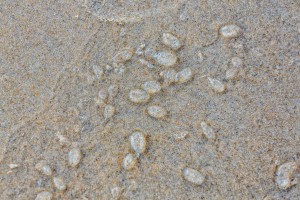
ASSATEAGUE — The invasion of thumbnail-sized, clear little jellies that raided the beaches at Assateague and in Ocean City to some degree last weekend continued this week, but the creatures are harmless and pose no danger to swimmers in the resort area.
Last week, thousands of tiny blobs of clear gelatinous creatures appeared in the ocean and on the beaches in Assateague and Ocean City, creating quite a stir for the countless visitors to the resort area on the busy holiday weekend. The ocean was thick with them and they washed up on the beaches in great numbers, but while the scope of the outbreak was somewhat rare, it is actually a natural phenomenon that should be enjoyed and not feared.
The creatures are called salps, and they belong to a small category of gelatinous invertebrates generally lumped into a large group called jellyfish.
National Aquarium General Curator Jack Cover just happened to be on vacation at Assateague last weekend and has vast knowledge about the salps as well as first-hand experience now.
“I actually had firsthand experience with them this weekend,” he said. “I was swimming with them and walking on them.”
Cover said a combination of winds and tides likely drove the salps closer to shore and when they found an abundant food source, the population exploded, creating waves of the small jellies in the ocean and on the beach.
“They belong to a category of what we call jellyfish, which is basically anything gelatinous,” he said. “Salps are just one little group of a much larger family and they are actually what we call a macro-plankton. They are filter feeders and have no stingers. They are little, clear barrels with water pumping through them and they feed on plankton.”
Assateague Island National Seashore Assistant Chief of Interpretation and Education Liz Davis has also been following the outbreak of salps on the barrier island this week. She agreed the phenomenon is likely tied to a variety of natural factors.
“Salp blooms can be directly tied to plankton blooms in the ocean,” she said. “When food is abundant, the salps can quickly and easily reproduce. When that happens, there are too many salps and not enough food to go around and they start to die off. So, this could be a typical case of population cycling.”
Davis said the salp bloom seemed to peak over the weekend, although the phenomenon had not abated as of Thursday.
“It’s still going on,” she said. “They’re not as abundant as a few days ago. Winds and tides play a role, as does where they are in the population cycle. It’s pretty cool.”
Assateague Coastkeeper Kathy Phillips has also experienced the salp invasion first hand.
“They’re pretty cool,” she said. “I love the way the washed up ones glitter like broken glass on the beach, but swimming in what feels like tapioca is not exactly enjoyable.”
Cover agreed the while salps are harmless in great numbers they can create a rather different texture in the water.
“When there are waves of them like we’ve seen this week, the water takes on kind of a milky texture,” he said. “Again, they are harmless, but the coating of them on the beach can be really slippery.”
Cover said the abundance of micro-plankton, which is the salp’s primary food source, close to shore is largely responsible for the outbreak.
“They’re opportunistic,” he said. “If there is a lot of food, they have the potential to reproduce quickly in big numbers. That’s what we’re seeing at Assateague and at Ocean City to a large degree. They’re mainly offshore, but when the Gulf Stream comes closer to shore, which is essentially like Route 95 in the ocean, strong inshore winds can push them in closer to the beach and they just go with the flow. The current and winds kind of dictate where they go and that’s why we’re seeing them on the beaches.”
Cover said the salp outbreak, while interesting, poses no threat to swimmers except for the inconvenience of walking on them or wading through them in the ocean.
“It’s not highly unusual, but this so-called bloom is pretty big,” he said. “People were freaking out, but there is no way they can harm you. Probably the biggest danger is slipping on them while walking on the beach. They’re just little chunks of gelatin. Naturally, there are a lot of animals in the ocean and occasionally humans get to see them up close and personal. We should take it as an opportunity to learn about something we maybe haven’t encountered before.”
Cover said given their druthers, the salps would rather not be in close to shore in the first place.
“For most of these little guys, it’s a bad day for any gelatinous animals when they get this close to the beach because the surf just breaks them up,” he said. “Who knows how long it will last. They’re like little jellies bobbing in the ocean and there’s not much mass to them.”
Unlike some of their cousins in the jellyfish family, the salps do not have any potential to harm swimmers. Cover said there have been sightings of other potentially dangerous jellies in and around the resort area recently.
“Another peculiar thing is that someone sent us a picture of a Portuguese Man O’ War from the beach in Ocean City,” he said. “That’s very rare. Obviously, they have stingers and wouldn’t be anything you would want to mess with.”
The National Aquarium in Baltimore this spring opened its new Living Seashore exhibit, which includes many of creatures that inhabit the waters in and around the resort area. Cover said recent unusual activity has created an opportunity for residents and visitors to learn first-hand about them in their own back yard.
“There are a lot of things out there, like the hammerheads we saw down there recently,” he said. “We recently opened our Living Seashore exhibit and some of these things are included. There is a big variety of critters out there and everything on or around the beach has a story to tell.”
While the salp outbreak at Assateague and Ocean City this week is likely largely due to a combination of natural factors, everything that happens on land in and around the ocean and bays contributes to the larger circle of life in the ocean and bays.
“There is a lot of human activity that directly or indirectly contributes to over-fertilizing the ocean,” he said. “With nutrient run-off in the bays and tributaries, we are creating blooms of algae and massive die-offs in the tributaries. The things that feed off that are also over-populating. It’s causing the blue ocean to turn green.”

